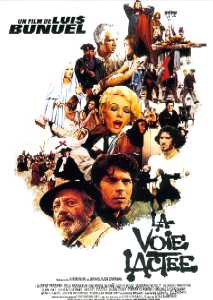The Milky Way (1969 film)
This article consists almost entirely of a plot summary. (November 2016) |
| The Milky Way | |
|---|---|
 French theatrical release poster | |
| Directed by | Luis Buñuel |
| Written by | Luis Buñuel Jean-Claude Carrière |
| Produced by | Serge Silberman |
| Starring | Paul Frankeur Laurent Terzieff Denis Manuel Daniel Pilon |
| Cinematography | Christian Matras |
| Edited by | Louisette Hautecoeur |
| Music by | Luis Buñuel |
| Distributed by | Medusa Distribuzione (Italy) CCFC (France) |
Release dates | 28 February 1969 (Italy) 15 March 1969 (France) 6 July 1969 (West Germany) |
Running time | 91 minutes (France) 101 minutes (Germany) 105 minutes (USA) |
| Countries | France Italy West Germany |
| Language | French |
The Milky Way (French: La Voie lactée) is a 1969 comedy-drama film directed by Luis Buñuel. It stars Paul Frankeur, Laurent Terzieff, Denis Manuel, and Daniel Pilon, and features the likes of Alain Cuny, Michel Piccoli, and Delphine Seyrig in its ensemble cast. Buñuel later called The Milky Way the first in a trilogy (along with his subsequent films The Discreet Charm of the Bourgeoisie and The Phantom of Liberty) about "the search for truth."[1]
The title of the film is taken from a popular name used for the
The plot is non-linear and functions as a highly symbolic travelogue across time and space, set over the last two thousand years. It encompasses much of Christian history. While using satire to critique religion from a skeptical perspective, the film also explores the act of spiritual quest and search for meaning.
The highly idiosyncratic film originally met with limited success, but, in the 21st century, it is very well-regarded amongst film enthusiasts and critics.
Plot
Two French vagrants, Pierre and Jean, decide to take the pilgrimage route from Paris to
Next, the pilgrims unsuccessfully seek food at an expensive restaurant, where the manager is explaining to his staff the controversy of the divinity of
After the pilgrims curse a passing car, it crashes and the driver is killed. Investigating the wreckage, they encounter a strange man (perhaps the Angel of Death or the
When the pilgrims reach Spain, they agree to take care of a donkey for two other men. These new men leave the pilgrims and travel to a nearby abbey where they watch the official desecration of a priest's grave because of the posthumous discovery of his heretical writings regarding the nature of the
On the outskirts of
Cast
- Paul Frankeur as Pierre Dupont
- Laurent Terzieff as Jean Duval
- Alain Cuny as the man with a cape
- Virgin Mary
- Bernard Verley as Jesus
- François Maistre as the crazy French priest
- Claude Cerval as the brigadier
- Muni as the mother superior
- Julien Bertheau as Monsieur Richard, the maître d'hôtel
- Ellen Bahl as Madame Garnier, a diner at the hotel
- Michel Piccoli as the Marquis de Sade
- Agnès Capri as the director of Institution Lamartine
- Michel Etcheverry as the inquisitor
- Pierre Clémenti as the Angel of Death
- Georges Marchal as the Jesuit
- Jean Piat as the Jansenist
- Denis Manuel as Rodolphe
- Daniel Pilon as François
- Claudio Brook as the bishop
- Julien Guiomar as the Spanish priest
- Marcel Pérès as the Spanish innkeeper
- Delphine Seyrig as the prostitute
- Jose Berzosa as Priscillian's head deacon
- Jean-Claude Carrière as Priscillian
- Augusta Carrière as the crucified nun
- Jean-Daniel Ehrmann as the man condemned by the inquisitor
- Claude Jetter as the young woman at the Spanish inn
- Pierre Maguelon as the Guardia Civil corporal
- Bernard Musson as the French innkeeper
- Christine Simon as Thérèse, the young woman held captive by the Marquis de Sade
- Michel Dacquin as Monsieur Garnier, a diner at the hotel (uncredited)
Analysis
In the film, two men travel the ancient pilgrimage road to Santiago de Compostela and meet embodiments of various Catholic heresies along the way. These religious events are based on actual historical documents. For instance, the archbishop whose corpse is exhumed and publicly burned is based on Archbishop Carranza of Toledo.[2] The film ends with the following text:
Everything in this film concerning the Catholic religion and the heresies it has provoked, especially from the dogmatic point of view, is rigorously exact. The texts and citations are taken either direct from Scripture, or modern and ancient works on theology and ecclesiastical history.[3]
The film plays with time. The two main characters often encounter individuals in the dress of various time periods throughout history, or historical events take place in the modern setting of the film, including scenes from the life of
Often, the encounters involve conversations or arguments regarding a specific Catholic doctrine or heresy and are intended to show the absurdity of making absolute statements about such topics as a "matter of fact". Two heresies prominent in the film are Priscillianism and Jansenism.
Reception
This section needs expansion. You can help by adding to it. (November 2016) |
On review aggregator website Rotten Tomatoes, The Milky Way has an approval rating of 95% based on 19 reviews, with an average score of 7.7/10.[4]
References
- ^ "The Milky Way". The Criterion Collection. Retrieved 18 April 2010.
- ^ ISBN 0-8166-4387-3. page 245.
- ^ French, Lawrence (26 February 2009). "Supernal Dreams: Jean-Claude Carriere on Luis Buñuel's Sublime Fantasy, "The Milky Way"". cinefantastiqueonline.com. Retrieved 18 April 2010.
- ^ "The Milky Way (1969) on RT". Rotten Tomatoes. Retrieved January 12, 2024.
External links
- The Milky Way at IMDb
- The Milky Way at AllMovie
- The Milky Way at the TCM Movie Database
- The Milky Way: The Heretic’s Progress an essay by Criterion Collection
- The Milky Way: Easy Striders an essay by Mark Polizzotti at the Criterion Collection
